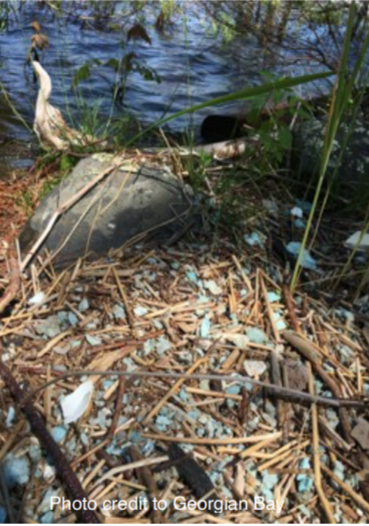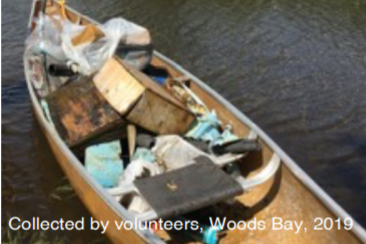Bear witness
Have you noticed the numerous collected pieces of mainly blue dock foam (although it comes in other colours) floating along your shoreline? You’ll see it washed up into crevices, not only at your cottage but on the outer islands where you picnic. It is not the blue we want to see reflected in the Bay at all, but it’s everywhere! We have a specific problem with dock foam pollution in Pointe au Baril and all-around Georgian Bay and we all need to participant in whatever ways we can to try and mitigate the problem and seek positive change. This article is meant to educate and encourage our members to participate in whatever ways you can towards driving positive change!
Get involved
Many of the organizations focused on the health of the Bay have undertaken numerous shoreline clean-ups and are adjusting those guidelines to incorporate the Covid-19 social distancing safety requirements:

- Georgian Bay Forever organizes them up and down the eastern coast during the summer months and through their “Families for Change” challenge,
- Georgian Bay Association organizes them as part of their new annual “Love your Bay” event,
- Georgian Bay Land Trust is constantly cleaning up garbage on their properties through their stewardship program and the
- Georgian Bay Biosphere Reserve educates children about nature, including the impact that human activity has on the environment through their “Lessons in a Backpack” educational programs offered to area schools. It is energizing – and hopeful – to see such volunteer and organizational energy focused on cleaning up our shorelines while educating ourselves and the next generation to become stewards of this precious Bay and all that it encompasses. This is a great example of how individual actions can drive change! Join a shoreline clean-up and get involved.
Educate others
• What does the data say? Shoreline clean-ups are carefully and thoroughly organized both in terms of the safety of the volunteers, the appropriate disposal of the garbage collected and the data being collected. All garbage collected is counted and tallied by GBF and GBA participants as well as by other organizations and municipalities doing their own cleanup.
The data tells a shocking story. Among the top 12 items found in GBF’s shoreline cleanups last summer, dock foam pieces were far and away the most prevalent item floating near the shore or blown up into the crevices – with a staggering 5000+ pieces, there were just too many to count. Second on the list was cigarette butts at around 1400 pieces. Doc
foam takes the prize by a long, long shot!1

• So what is this pollutant called dock foam? The dock Styrofoam we see most commonly littering the shores of the Bay is extruded polystyrene (XPS). It is recognizable blue foam used for flotation under
docks. Polystyrene is largely inert, made from petroleum products and consisting of small polystyrene beads that are fused together.
When formed into dock billets, it is generally not protected so exposure to water and sun over time will cause it to break down. This process is frequently accelerated by muskrats who like to gnaw away at
the foam and create a safe and cozy sleeping space for themselves. This releases thousands of pieces of various sizes directly into the water. As this break down continues, the pieces become smaller and smaller and are virtually indestructible.
They get covered by dirt and algae and animals confuse them for food. When swallowed by fish and waterfowl, they can clog their intestines, preventing digestion of food and leading to starvation. XPS is difficult to recycle and takes decades or longer to break down in the environment. Basically, it will last for millions of years because it is not biodegradable2 and therefore presents a serious pollution and environmental harm.
What about the chemicals in the foam? No one yet knows what the impact of the chemicals in the foam will have on the animals that ingest them or the humans who eat the fish or drink water from the Bay. GBF has started the “Say NO to Foam” project. The project will gather the science around the chemical harm from samples of dock foam. Hopefully more information will be available by this spring, so stay tuned …
Take Action!
- Clean up your shoreline. Get your family together with clear plastic garbage bags and pick up all the foam on your property. Take those bags to the PaB Municipal Waste Facility on the South Shore Road. They will take bags of small pieces only. The very large pieces must be taken to Site 9 for disposal.
- Do you own an older dock? The source of the dock foam pollution we are seeing is likely present in older or abandoned docks. If you have an older dock please consider replacing those XPS foam blocks before they continue to degrade releasing millions of Styrofoam particles into the Bay. Then replace them with some of the newer products on the market today mentioned below. If you have a new dock and have towed your old one somewhere and abandoned it, according to the TOA, you are still responsible for its safe removal. Abandoned dock materials can be dismantled into manageable sized pieces and disposed of at the Devil’s Elbow, Sheep Head, Crane or Healey Lake transfer sites in the southern portion of the Township, as well as the Site 9 Landfill site in the north Archipelago.
- Secure your docks for the winter. With the high water, heaving winter ice and storm surges being the new normal, please ensure that your docks are well secured to withstand what Mother Nature brings to PaB this winter.
- Replace XPS with encapsulated polystyrene. Most dock manufacturers do not use XPS anymore. Today there are several other flotation options that will not release plastics into the environment, including using 55- gallon (208 litre) plastic drums, resin-encapsulated foam billets, and steel floats. While there’s no doubt that XPS is cheaper compared to other options, the cost to the environment is much higher because pollution and damage will last forever. If you are planning to replace your dock soon, consider using resin-encapsulated foam or another flotation option that will not release plastics into the environment.
Seek Change
Positive developments are occurring at the Township of the Archipelago (TOA). On December 13, 2019, the TOA passed a resolution to initiate an education program in cooperation with ratepayer associations, Georgian Bay Forever, Georgian Bay Biosphere Reserve and the Great Lakes mayors regarding the environmental impact of foam docks, including lobbying efforts to encourage the provincial government to ban the use of foam
for docks. A great start!3
- But let’s keep the momentum going …Seek change from politicians and keep the pressure on about this issue.
- Contact dock manufacturers and retailers, such as our local contractors, Dock Kings, Scott Kemp at the Ironworker, McRhode, Premium Dock in Parry Sound, Rona and Canadian Tire. If they are selling XPS for docks, let them know your opinion of it.
Because, sadly, this is only the tip of the iceberg. Approximately 22 million pounds of plastic enter the Great Lakes each year including Georgian Bay. Much of this plastic pollution is deposited on the ecologically diverse and productive shorelines, compromising these important habitats.4

Individual actions can drive change …
1 “Top Ten Items You Picked up from Georgian Bay Shorelines,” Georgian Bay Forever, Vol. 10, Issue 3, Fall 2019, pg. 5.
2 Max Roman Dilthey, “How long does it take Styrofoam to Break Down?”, Sciencing, Updated April 19, Retrieved on March 28 at https://sciencing.com/long-styrofoam-break-down-5407877.html
3 Thompson, Sandy. “The Big and Very Tiny Problem with Dock Foam,” Georgian Bay Association, Vol.30, No, 1, Spring 2020. Sandy’s article was a major source of information for this piece.
4 “Top Ten Items You Picked up from Georgian Bay Shorelines,” Georgian Bay Forever, Vol. 10, Issue 3, Fall 2019, pg. 5.